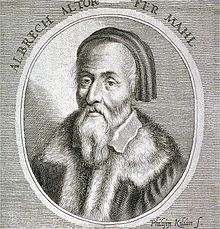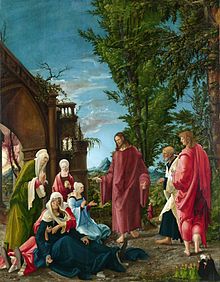Albrecht Altdorfer
Albrecht Altdorfer | |
|---|---|
 Albrecht Altdorfer portrait by Philipp Kilian | |
| Born | c. 1480 |
| Died | 12 February 1538 (aged 57–58) |
| Nationality | German |

Albrecht Altdorfer (c. 1480—12 February 1538) was a German painter, engraver and architect of the Renaissance working in
Biography
Altdorfer was born in Regensburg or Altdorf around 1480.
He acquired an interest in art from his father, Ulrich Altdorfer, who was a painter and miniaturist. At the start of his career, he won public attention by creating small, intimate modestly scaled works in unconventional media and with eccentric subject matter. He settled in the
Around 1511 or earlier, he travelled down the river and south into the Alps, where the scenery moved him so deeply that he became the first
In 1529, he executed
In that period his works are influenced by artists such as Giorgione and Lucas Cranach, as shown by his Crucifixion. In 1535, he was in Vienna. He died at Regensburg in 1538.
The remains of Altdorfer's surviving work comprises 55 panels, 120 drawings, 125 woodcuts, 78 engravings, 36 etchings, 24 paintings on parchment, and fragments from a mural for the bathhouse of the Kaiserhof in Regensburg. This production extends at least over the period 1504–1537. He signed and dated each one of his works.
Painting


Altdorfer was the pioneer painter of pure landscape, making them the subject of the painting, as well as compositions dominated by their landscape; these
Also, he often painted scenes of historical and biblical subjects, set in atmospheric landscapes. His best religious scenes are intense, with their glistening lights and glowing colours sometimes verging on the expressionistic. They often depict moments of intimacy between Christ and his mother, or various saints. His sacral masterpiece and one of the most famous religious works of art of the later
in 1923 and 1930. Both these paintings share a similar formal structure that consists of an open landscape that is seen beyond and through the opening of a dark grotto. The date of completion on the resurrection panel is 1518.Altdorfer often distorts perspective to subtle effect. His donor figures are often painted completely out of scale with the main scene, as in paintings of the previous centuries. He also painted some portraits; overall his painted oeuvre was not large. In his later works, Altdorfer moved more towards mannerism and began to depict the human form to the conformity of the Italian model, as well as dominate the picture with frank colors.
Paintings in Munich

Wood, 158.4 × 120.3 cm Alte Pinakothek, Munich
His rather atypical Battle of Issus (or of Alexander) of 1529 was commissioned by William IV, Duke of Bavaria as part of a series of eight historical battle scenes destined to hang in the Residenz in Munich. Albrecht Altdorfer's depiction of the moment in 333 BCE when Alexander the Great routed Darius III for supremacy in Asia Minor is vast in ambition, sweeping in scope, vivid in imagery, rich in symbols, and obviously heroic—the Iliad of painting, as literary critic Friedrich Schlegel suggested[6] In the painting, a swarming cast of thousands of soldiers surround the central action: Alexander on his white steed, leading two rows of charging cavalrymen, dashes after a fleeing Darius, who looks anxiously over his shoulder from a chariot. The opposing armies are distinguished by the colors of their uniforms: Darius' army in red and Alexander's in blue. The upper half of The Battle of Alexander expands with unreal rapidity into an arcing panorama comprehending vast coiling tracts of globe and sky. The victory also lies on the planar surface; The sun outshone the moon just as the Imperial and allied army successfully repel the Turks.[6] By making the mass number of soldiers blend within the landscape/painting, it shows that he believed that the usage and depiction of landscape was just as significant as a historical event, such as a war. He renounced the office of Mayor of Regensburg to accept the commission. Few of his other paintings resemble this apocalyptic scene of two huge armies dominated by an extravagant landscape seen from a very high viewpoint, which looks south over the whole Mediterranean from modern Turkey to include the island of Cyprus and the mouths of the Nile and the Red Sea (behind the isthmus to the left) on the other side. However his style here is a development of that of a number of miniatures of battle-scenes he had done much earlier for Maximilian I in his illuminated manuscript Triumphal Procession in 1512–14. It is thought to be the earliest painting to show the curvature of the Earth from a great height.
The Battle is now in the Alte Pinakothek, which has the best collection of Altdorfer's paintings, including also his small St. George and the Dragon (1510), in oil on parchment, where the two figures are tiny and almost submerged in the lush, dense forest that towers over them. Altdorfer seems to exaggerate the measurements of the forest in comparison to the figures: the leaves appear to be larger than the horse, showing the significance of nature and landscape. He also emphasizes line within the work, by displaying the upward growth of the forest with the vertical and diagonal lines of the trunks. There is a small opening of the forest on the lower right hand corner that provides a rest for your eyes. It serves to create depth within the painting and is the only place you can see the characters. The human form is completely absorbed by the thickness of the forest. Fantastic light effects provide a sense of mystery and dissolve the outline of objects. Without the contrast of light, the figures would blend in with its surrounding environment. Altdorfer's figures are invariably the complement of his romantic landscapes; for them he borrowed Albrecht Dürer's inventive iconography, but the panoramic setting is personal and has nothing to do with the fantasy landscapes of the Netherlands[7] A Susanna in the Bath and the Stoning of the Elders (1526) set outside an Italianate skyscraper of a palace shows his interest in architecture. Another small oil on parchment, Danube Landscape with Castle Wörth (c. 1520) is one of the earliest accurate topographical paintings of a particular building in its setting, of a type that was to become a cliché in later centuries.
Printmaking
Altdorfer was a significant
Public life
As the superintendent of the municipal buildings Altdorfer had overseen the construction of several commercial structures, such as a slaughterhouse and a building for wine storage, possibly even designing them. He was considered to be an outstanding politician of his day. In 1517 he was a member of the "Ausseren Rates", the council on external affairs, and in this capacity was involved in the expulsion of the Jews, the destruction of the synagogue and in its place the construction of a church and shrine to the Schöne Maria that occurred in 1519. Altdorfer made etchings of the interior of the synagogue and designed a woodcut of the cult image of the Schöne Maria.[11] In 1529–1530 he was also charged with reinforcing certain city fortifications in response to the Turkish threat.
Albrecht's brother, Erhard Altdorfer, was also a painter and printmaker in woodcut and engraving, and a pupil of Lucas Cranach the Elder.

See also
- 8121 Altdorfer, asteroid named after Altdorfer
- Danube school
- Early Renaissance painting
- List of landscapes by Albrecht Altdorfer
References
- ISBN 978-0198691372.
- ISBN 0-500-20162-5.
- ^ image
- ^ image
- ISBN 9780226906010.
- ^ a b Dobrzynski, Judith H. (January 8, 2010). "An Epic Poem in Paint: The story of 'The Battle of Issus' and Albrecht Altdorfer". The Wall Street Journal.
- ISBN 0-500-20162-5.
- ^ "Albrecht Altdorfer: Landscape with a Double Spruce in the Foreground (1993.1097) | Heilbrunn Timeline of Art History | The Metropolitan Museum of Art". Metmuseum.org. 2013-09-04. Retrieved 2013-12-21.
- ISBN 9780195334661.
- ISBN 9780486209548. Retrieved 5 July 2014.
- ^ Pioch, Nicolas. "Altdorfer, Albrecht".
Further reading
- Alte Pinakotek, Munich; (Summary Catalogue -various authors),1986, Edition Lipp, ISBN 3-87490-701-5
- ISBN 0-948462-46-9
- Christoph Wagner, Oliver Jehle (eds.), Albrecht Altdorfer. Kunst als zweite Natur, 2012, Schnell & Steiner Verlag, Regensburg (= Regensburger Studien zur Kunstgeschichte, Vol. 17), ISBN 978-3-7954-2619-4
- Jochen Sander, Stefan Roller, ISBN 978-3-7774-2266-4(exhibition catalogue Städel Museum, Frankfort, November 5, 2014 - February 2015 and Kunsthistorisches Museum, Vienna, March 17 - June 14, 2015)
External links
- Works by Albrecht Altdofer at the Museum of New Zealand Te Papa Tongarewa
- Albrecht Altdorfer collection at the Israel Museum. Retrieved September 2016.
- Works by Altdorfer at Zeno.org
- Albrecht Altdorfer in the "History of Art" Archived 2021-04-21 at the Wayback Machine
- Albrecht Altdorfer Wallpapers
- Page at artcyclopedia.com
- Page at ibiblio.org
- Artvibrations Archive: https://web.archive.org/web/20110211004452/http://www.artvibrations.com/AlbrechtAltdorfer/
- Albrecht Altdorfer Paintings Gallery (Public Domain Paintings - www.art.onilm.com)
- Prints & People: A Social History of Printed Pictures, an exhibition catalog from The Metropolitan Museum of Art (fully available online as PDF), which contains material on Albrecht Altdorfer (see index)
